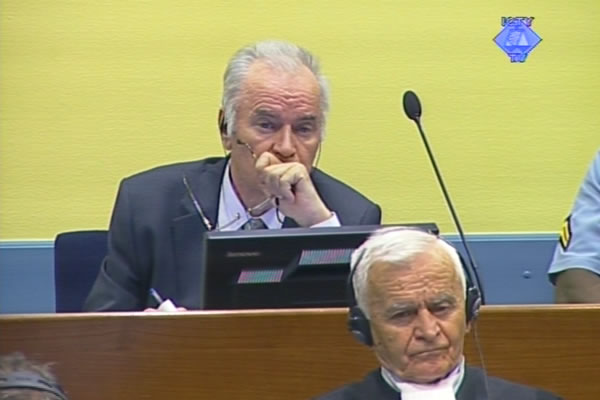Home
SIMILARITIES AND DIFFERENCES BETWEEN US ARMY AND MLADIC’S ARMY
Ratko Mladic’s defense counsel contends that the Bosnian Serb army attacked Sarajevo following the US military doctrine called ‘shock and awe’. The doctrine calls for the army with a superior artillery element to demonstrate force as soon as possible to discourage and defeat the enemy. Prosecution witness Pyers Tucker replied that the key of the doctrine was to ‘limit civilian casualties as much as possible, and that was not the case in the VRS attacks on Sarajevo’
 Ratko Mladic in the courtroom
Ratko Mladic in the courtroom In the cross-examination of British colonel Pyers Tucker, Ratko Mladic’s defense counsel strove to justify the actions of the Bosnian Serb army during the siege of Sarajevo. The defense counsel contested the witness’s claims that the artillery and sniper attacks on the city ‘were acts of terrorism and punishment’. As aide de camp to UNPROFOR commander in BH Philippe Morillon the witness was in Sarajevo from October 1992 to March 1993.
Describing the ‘punishment attacks’ of the VRS artillery yesterday, the witness said that the civilian parts of Sarajevo from which the BH Army had previously opened fire on Serb positions were shelled in retaliation. Defense counsel Dragan Ivetic reminded the witness that in his evidence at the trial of Stanislav Galic, former commander of the Sarajevo-Romanija Corps, he said that he had once received a report stating that artillery fire had been opened from the Kosevo Hospital on the VRS positions. The defense counsel put it to the witness that it was legitimate to return fire in that case. The witness replied that if you want to ‘retaliate’ you must be very careful about what you fire on. ‘If you see a hospital, you should think twice before returning fire’, the witness said, adding that in such cases the British Army troops must not respond.Other hospitals in Sarajevo, not only the Kosevo Hospital, were shelled too, the witness added, and there were no reports that fire had been opened from those hospitals on Bosnian Serb positions.
Contesting the witness’s claim that the artillery and sniper attacks were ‘terrorist’, the defense counsel argued that the VRS used the same doctrine that is implemented by NATO and US Army. The doctrine is called ‘shock and awe’ and it calls for the armed forces with a superior artillery element to demonstrate force as soon as possible to discourage and defeat the enemy avoiding further casualties. The witness was aware of the doctrine. Its key is to ‘limit civilian casualties as much as possible, but that was not the case in the VRS attacks on Sarajevo’.
The defense counsel recalled parts of the witness’s statement where he said that UNPROFOR staff established that a shell that hit Morillon’s headquarters had been fired from the BH Army positions. Today the witness confirmed that. The witness didn’t recant on his testimony at Radovan Karadzic’s trial that after he continued his service in Germany he heard from a former UNPROFOR member that the shell that hit the town market in the Markale 1 incident had been fired from the Muslim positions. Asked about the name of the person, the witness couldn’t remember.
The witness agreed that the Muslim side sometimes exaggerated the suffering of its people in order to push for an international intervention. Also, the witness didn’t deny that the Muslim side sometimes obstructed the repairs of the water and electricity supply system for Sarajevo and that in some cases weapons were smuggled in on humanitarian aid convoys. However, the witness emphasized that keeping the supply lines open for the people in Sarajevo depended exclusively on the good will of Serb military and political leadership. ‘They used every excuse to turn off the tap if necessary or to open it just a little bit’, Pyers Tucker concluded. Former head of UN observers in Sarajevo John Wilson is scheduled to start his evidence tomorrow.
Linked Reports
- Case : Mladic
- 2012-10-08 SARAJEVO WAS PUNISHED AND TERRORIZED
- 2012-10-08 MLADIC THREATENS TO GO ON HUNGER STRIKE
- 2012-10-05 COMMANDER AND SUPREME COMMANDER
- 2012-10-10 MLADIC HAD 'MORE CANNONS THAN SOLDIERS'
- 2012-10-11 GENERAL MLADIC 'OUT OF CONTROL'
- 2012-10-12 MLADIC COULD ORDER A CEASE FIRE IF HE WANTED
